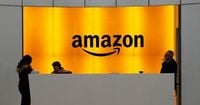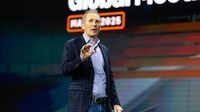Pink slips are flying once again in the tech world, and this time, Amazon is at the center of the storm. On October 28, 2025, the e-commerce and cloud giant began laying off 14,000 corporate employees—roughly 4% of its white-collar workforce. The move is part of a larger plan that could ultimately see as many as 30,000 jobs eliminated, amounting to a 10% reduction in Amazon’s corporate ranks, according to Reuters and Business Insider.
For many, the news of Amazon’s sweeping layoffs feels like déjà vu, echoing the massive cuts seen at Meta and other tech companies in recent years. But as the dust settles, a bigger question looms: Is this the start of a new wave of white-collar job losses across America? And is artificial intelligence really to blame for all of it?
Amazon’s leadership is quick to point to familiar culprits—bureaucracy, organizational bloat, and the need to move faster in an era defined by rapid technological change. In a memo to employees, Beth Galetti, Amazon’s senior vice president of people experience and technology, wrote, “We’re convinced that we need to be organized more leanly, with fewer layers and more ownership, to move as quickly as possible for our customers and business.” She added that the layoffs are about “reducing layers, increasing ownership and helping reduce bureaucracy,” with a nod to the efficiency gains possible in “this generation of AI.”
Yet, the company is careful not to lay the blame entirely at AI’s feet. While automation and artificial intelligence are clearly shaping the future of work, researchers at Gartner suggest that Amazon’s cuts represent a “strategic ‘talent remix’”—a reallocation of resources to high-priority business areas rather than a direct result of robots and algorithms replacing humans. In fact, Gartner found that less than 1% of the layoffs it tracked in the first half of 2025 were directly caused by AI taking over jobs. “AI is not yet ready to replace the large majority of jobs,” researchers noted. “In most cases, staffing shifts appear to be a byproduct of freeing up capital expenditures for investments and not a direct consequence of AI replacing human roles.”
Still, the specter of AI looms large in the minds of employees and investors alike. Amazon CEO Andy Jassy warned earlier in the summer that the company expected to pare down its white-collar workforce as it “gets efficiency gains from using AI extensively across the company.” He admitted, “It’s hard to know exactly where this nets out over time, but in the next few years, we expect that this will reduce our total corporate workforce.”
For now, Amazon’s operations workforce—especially at its much-touted HQ2 in Pentagon City—remains mostly untouched. “These layoffs involve our corporate workforce and not our operations workforce,” Amazon spokesperson Kelly Nantel told ARLnow, allaying fears that the company’s Virginia expansion would be derailed. In fact, the Arlington County Board recently granted Amazon a three-year extension on its plans to build Phase 2 of the HQ2 campus, including the eye-catching “helix” tower, though there have been no new updates since June.
The broader business landscape is watching Amazon’s moves closely. After all, when Meta cut 11,000 jobs in late 2022, it kicked off a so-called “Year of Efficiency” that ultimately led to some 250,000 layoffs across corporate America, as reported by Business Insider. Now, with the labor market in what’s being called a “Great Freeze”—companies neither hiring nor firing in large numbers—there’s concern that Amazon’s decision could open the floodgates. “About 20 more Amazon-sized layoffs would send the labor market off the rails,” wrote Business Insider’s Bartie Scott, Andy Kiersz, and Madison Hoff.
But is AI really the villain in this story? Not everyone is convinced. “I see this as mainly a correction to pandemic-era dynamics rather than some new thing like AI that’s striking these companies,” Ernie Tedeschi, a nonresident senior fellow at The Budget Lab at Yale, told Business Insider. In other words, companies may be using AI as a convenient scapegoat for overhiring during the tech boom of the early 2020s and now pulling back as growth slows.
Other major employers are making similar moves. UPS announced it had already cut 48,000 jobs in 2025, while Target unveiled plans to eliminate 1,800 corporate positions. General Motors also laid off about 1,750 employees, citing “slower near-term EV adoption” and an “evolving regulatory environment.” The trend has some experts worried about the stability of the broader white-collar job market, especially if companies start letting people go without hiring replacements.
For human resources leaders, the challenge now is to balance efficiency with empathy. Erin DeVito, general manager North America at Impact International, told HR Executive that HR’s job is to “keep the human conversation alive, ensuring efficiency doesn’t come at the cost of engagement, capability and culture.” She urges organizations to ask tough questions: “If organizations say they want to operate leaner and faster, question why. If it’s truly about creating a better experience for customers, then the experience inside our organizations must match.”
DeVito emphasizes that workforce reductions are not just about trimming headcount. “Organizations shouldn’t just be planning for smaller workforces, but talent populations that will be fundamentally different,” she said. HR’s role, she argues, is to help design for that difference, not just survive it.
Transparency and communication are also key to navigating what Gartner calls the “contagion effect of layoffs.” The research firm advises, “Being clear about what your organization is trying to achieve with AI shows respect for your workforce, compassion for their anxieties and clarity about the near-term future.” If layoffs are unavoidable, DeVito warns against moving too quickly, especially if automation and AI play a role. “Many outcomes may still depend on practical know-how, judgement and relationships. If those humans leave, capability gaps could appear that are costly and slow to rebuild.”
The financial markets are keeping a close eye on these developments as well. Despite Amazon’s stock rising 43% over the past five years, it has lagged behind peers like Nvidia, which soared 1,521% during the same period. Investors are concerned that Amazon may be falling behind in the so-called “AI arms race.” Meanwhile, the Federal Reserve’s two interest rate cuts in 2025 have given borrowers some relief, but Fed Chair Jerome Powell has cautioned that future cuts are not guaranteed.
As the tech industry—and the wider corporate world—grapples with these seismic shifts, one thing is clear: the future of work is being rewritten in real time. Whether AI is the main author or just a supporting player remains to be seen, but the human impact of these changes is undeniable. For Amazon’s thousands of newly unemployed workers, and for those who remain, the next chapter is full of uncertainty—and opportunity.


